
  |
Myths & Facts Online
The 1967 Six-Day War
By Mitchell G. Bard
“Arab
governments were prepared to accept Israel after the Suez War.”
“Israel's military
strike was unprovoked.”
“Nasser had the
right to close the Straits of Tiran to Israeli shipping.”
“The United States
helped Israel defeat the Arabs in six days.”
“Israel attacked
Jordan to capture Jerusalem.”
“Israel did not
have to shoot first.”
“Israel viewed
the territories it captured as conquered lands that were now part of Israel
and had no intention of negotiating over their return.”
“Israel expelled
peaceful Arab villagers from the West Bank and prevented them from returning
after the war.”
“Israel imposed
unreasonable restrictions on the Palestinians in the West Bank, Gaza and
East Jerusalem.”
“During the 1967
War, Israel deliberately attacked the USS Liberty.”
"Arab governments were prepared to accept Israel after the Suez War."
FACT
Israel consistently expressed a desire to negotiate with its neighbors. In an address to the UN General Assembly on October 10, 1960, Foreign Minister Golda Meir challenged Arab leaders to meet with Prime Minister David Ben-Gurion to negotiate a peace settlement. Nasser answered on October 15, saying that Israel was trying to deceive the world, and reiterating that his country would never recognize the Jewish State.1
The Arabs were equally adamant in their refusal to negotiate a separate settlement for the refugees. As Nasser told the United Arab Republic National Assembly March 26, 1964:
Israel and the imperialism around us, which confront us, are two separate things. There have been attempts to separate them, in order to break up the problems and present them in an imaginary light as if the problem of Israel is the problem of the refugees, by the solution of which the problem of Palestine will also be solved and no residue of the problem will remain. The danger of Israel lies in the very existence of Israel as it is in the present and in what she represents.2
Meanwhile, Syria used the Golan Heights, which tower 3,000 feet above the Galilee, to shell Israeli farms and villages. Syria's attacks grew more frequent in 1965 and 1966, while Nasser's rhetoric became increasingly bellicose: "We shall not enter Palestine with its soil covered in sand," he said on March 8, 1965. "We shall enter it with its soil saturated in blood."3
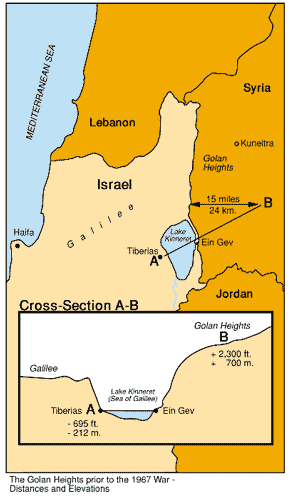
Again, a few months later, Nasser expressed the Arabs' aspiration: "...the full restoration of the rights of the Palestinian people. In other words, we aim at the destruction of the State of Israel. The immediate aim: perfection of Arab military might. The national aim: the eradication of Israel."4
"Israel's military strike in 1967 was unprovoked."
FACT
A combination of bellicose Arab rhetoric, threatening behavior and, ultimately, an act of war left Israel no choice but preemptive action. To do this successfully, Israel needed the element of surprise. Had it waited for an Arab invasion, Israel would have been at a potentially catastrophic disadvantage.
While Nasser continued to make speeches threatening war, Arab terrorist attacks grew more frequent. In 1965, 35 raids were conducted against Israel. In 1966, the number increased to 41. In just the first four months of 1967, 37 attacks were launched.5
Meanwhile, Syria's attacks on Israeli kibbutzim from the Golan Heights provoked a retaliatory strike on April 7, 1967, during which Israeli planes shot down six Syrian MiGs. Shortly thereafter, the Soviet Union — which had been providing military and economic aid to both Syria and Egypt — gave Damascus information alleging a massive Israeli military buildup in preparation for an attack. Despite Israeli denials, Syria decided to invoke its defense treaty with Egypt.
On May 15, Israel's Independence Day, Egyptian troops began moving into the Sinai and massing near the Israeli border. By May 18, Syrian troops were prepared for battle along the Golan Heights.
Nasser ordered the UN Emergency Force, stationed in the Sinai since 1956, to withdraw on May 16. Without bringing the matter to the attention of the General Assembly, as his predecessor had promised, Secretary-General U Thant complied with the demand. After the withdrawal of the UNEF, the Voice of the Arabs proclaimed (May 18, 1967):
As of today, there no longer exists an international emergency force to protect Israel. We shall exercise patience no more. We shall not complain any more to the UN about Israel. The sole method we shall apply against Israel is total war, which will result in the extermination of Zionist existence.6
An enthusiastic echo was heard May 20 from Syrian Defense Minister Hafez Assad:
Our forces are now entirely ready not only to repulse the aggression, but to initiate the act of liberation itself, and to explode the Zionist presence in the Arab homeland. The Syrian army, with its finger on the trigger, is united....I, as a military man, believe that the time has come to enter into a battle of annihilation.7
On May 22, Egypt closed the Straits of Tiran to all Israeli shipping and all ships bound for Eilat. This blockade cut off Israel's only supply route with Asia and stopped the flow of oil from its main supplier, Iran. The following day, President Johnson expressed the belief that the blockade was illegal and unsuccessfully tried to organize an international flotilla to test it.
Nasser was fully aware of the pressure he was exerting to force Israel's hand. The day after the blockade was set up, he said defiantly: "The Jews threaten to make war. I reply: Welcome! We are ready for war."8
Nasser challenged Israel to fight almost daily. "Our basic objective will be the destruction of Israel. The Arab people want to fight," he said on May 27.9 The following day, he added: "We will not accept any...coexistence with Israel...Today the issue is not the establishment of peace between the Arab states and Israel....The war with Israel is in effect since 1948."10
King Hussein of Jordan signed a defense pact with Egypt on May 30. Nasser then announced:
The armies of Egypt, Jordan, Syria and Lebanon are poised on the borders of Israel...to face the challenge, while standing behind us are the armies of Iraq, Algeria, Kuwait, Sudan and the whole Arab nation. This act will astound the world. Today they will know that the Arabs are arranged for battle, the critical hour has arrived. We have reached the stage of serious action and not declarations.11
President Abdur Rahman Aref of Iraq joined in the war of words: "The existence of Israel is an error which must be rectified. This is our opportunity to wipe out the ignominy which has been with us since 1948. Our goal is clear -- to wipe Israel off the map."12 On June 4, Iraq joined the military alliance with Egypt, Jordan and Syria.
The Arab rhetoric was matched by the mobilization of Arab forces. Approximately 250,000 troops (nearly half in Sinai), more than 2,000 tanks and 700 aircraft ringed Israel.13
By this time, Israeli forces had been on alert for three weeks. The country could not remain fully mobilized indefinitely, nor could it allow its sea lane through the Gulf of Aqaba to be interdicted. Israel's best option was to strike first.On June 5, the order was given to attack Egypt.
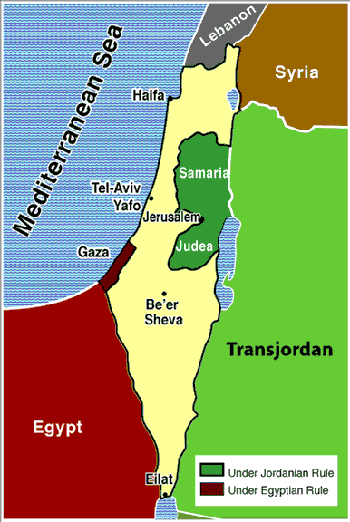
Israel Before the 1967 War
"Nasser had the right to close the Straits of Tiran to Israeli shipping."
FACT
In 1956, the United States gave Israel assurances that it recognized the Jewish State's right of access to the Straits of Tiran. In 1957, at the UN, 17 maritime powers declared that Israel had a right to transit the Strait. Moreover, the blockade violated the Convention on the Territorial Sea and Contiguous Zone, which was adopted by the UN Conference on the Law of the Sea on April 27, 1958.14
The closure of the Strait of Tiran was the casus belli in 1967. Israel's attack was a reaction to this Egyptian first strike. President Johnson acknowledged as much after the war (June 19, 1967):
If a single act of folly was more responsible for this explosion than any other it was the arbitrary and dangerous announced decision that the Strait of Tiran would be closed. The right of innocent maritime passage must be preserved for all nations.15
"The United States helped Israel defeat the Arabs in six days."
FACT
The United States tried to prevent the war through negotiations, but it could not persuade Nasser or the other Arab states to cease their belligerent statements and actions. Still, right before the war, Johnson warned: "Israel will not be alone unless it decides to go alone."16 Then, when the war began, the State Department announced: "Our position is neutral in thought, word and deed."17
Moreover, while the Arabs were falsely accusing the United States of airlifting supplies to Israel, Johnson imposed an arms embargo on the region (France, Israel's other main arms supplier, also embargoed arms to Israel).
By contrast, the Soviets were supplying massive amounts of arms to the Arabs. Simultaneously, the armies of Kuwait, Algeria, Saudi Arabia and Iraq were contributing troops and arms to the Egyptian, Syrian and Jordanian fronts.18
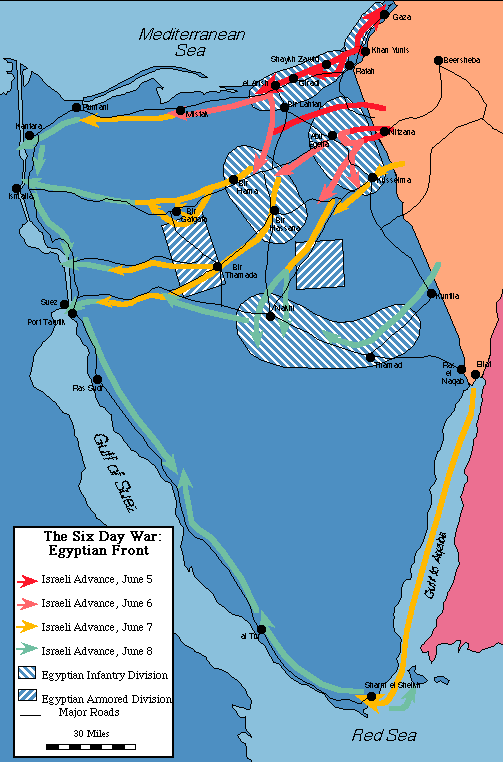
"Israel attacked Jordan to capture Jerusalem."
FACT
Prime Minister Levi Eshkol sent a message to King Hussein saying Israel would not attack Jordan unless he initiated hostilities. When Jordanian radar picked up a cluster of planes flying from Egypt to Israel, and the Egyptians convinced Hussein the planes were theirs, he then ordered the shelling of West Jerusalem. It turned out the planes were Israel's, and were returning from destroying the Egyptian air force on the ground. Meanwhile, Syrian and Iraqi troops attacked Israel's northern frontier.
Had Jordan not attacked, the status of Jerusalem would not have changed during the course of the war. Once the city came under fire, however, Israel needed to defend it, and, in doing so, took the opportunity to unify its capital once and for all.
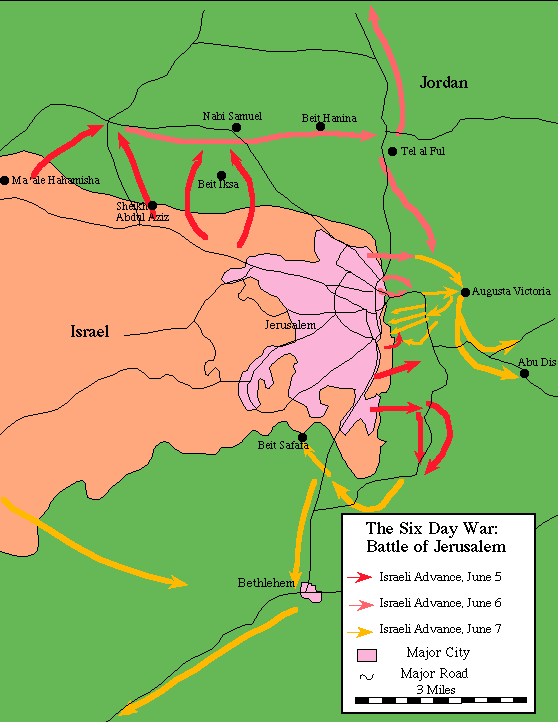
"Israel did not have to shoot first."
FACT
After just six days of fighting, Israeli forces broke through the enemy lines and were in a position to march on Cairo, Damascus and Amman. A cease�fire was invoked on June 10. The victory came at a very high cost. In storming the Golan Heights, Israel suffered 115 dead � roughly the number of Americans killed during Operation Desert Storm. Altogether, Israel lost twice as many men � 777 dead and 2,586 wounded � in proportion to her total population as the U.S. lost in eight years of fighting in Vietnam.19 Also, despite the incredible success of the air campaign, the Israeli Air Force lost 46 of its 200 fighters.20 Had Israel waited for the Arabs to strike first, as it did in 1973, and not taken preemptive action, the cost would certainly have been much higher and victory could not have been assured.
"Israel viewed the territories it captured as conquered lands that were now part of Israel and had no intention of negotiating over their return."
FACT
By the end of the war, Israel had captured enough territory to more than triple the size of the area it controlled, from 8,000 to 26,000 square miles. The victory enabled Israel to unify Jerusalem. Israeli forces had also captured the Sinai, the Golan Heights, the Gaza Strip and the West Bank.
Israel's leaders fully expected to negotiate a peace agreement with their neighbors that would involve some territorial compromise. Almost immediately after the war, Israel's leaders expressed their willingness to negotiate a return of at least some of the territories. Israel subsequently returned all of the Sinai to Egypt, territory claimed by Jordan was returned to the Hashemite Kingdom, and nearly all of the Gaza Strip and more than 40 percent of the West Bank was given to the Palestinians to establish the Palestinian Authority.
To date, approximately 93 percent of the territories won in the defensive war have been given by Israel to its Arab neighbors as a result of negotiations. This demonstrates Israel's willingness to trade land for peace.
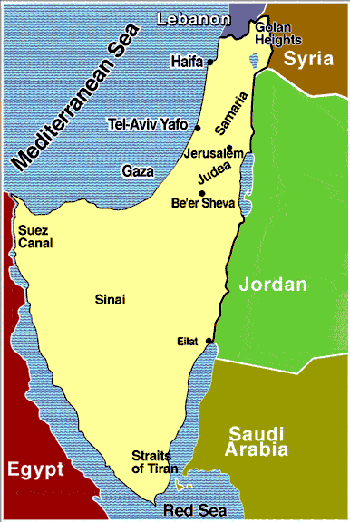
Cease-Fire lines after the Six-Day War
"Israel expelled peaceful Arab villagers from the West Bank and prevented them from returning after the war."
FACT
After Jordan launched its attack on June 5, approximately 325,000 Palestinians living in the West Bank fled.21 These were Jordanian citizens who moved from one part of what they considered their country to another, primarily to avoid being caught in the cross fire of a war.
A Palestinian refugee who was an administrator in a UNRWA camp in Jericho said Arab politicians had spread rumors in the camp. "They said all the young people would be killed. People heard on the radio that this is not the end, only the beginning, so they think maybe it will be a long war and they want to be in Jordan."22
Some Palestinians who left preferred to live in an Arab state rather than under Israeli military rule. Members of various PLO factions fled to avoid capture by the Israelis. Nils-G�ran Gussing, the person appointed by the UN Secretary-General to investigate the situation, found that many Arabs also feared they would no longer be able to receive money from family members working abroad.23
Israeli forces ordered a handful of Palestinians to move for "strategic and security reasons." In some cases, they were allowed to return in a few days, in others Israel offered to help them resettle elsewhere.24
Israel now ruled more than three-quarters of a million Palestinians � most of whom were hostile to the government. Nevertheless, more than 9,000 Palestinian families were reunited in 1967. Ultimately, more than 60,000 Palestinians were allowed to return.25
"Israel imposed unreasonable restrictions on the Palestinians in the West Bank, Gaza Strip and East Jerusalem."
FACT
After the 1967 War, Israel chose not to annex the West Bank or Gaza Strip and instituted a military administration instead. This was necessary as an interim step until negotiations could resolve the future of the territories. This was by no means an ideal situation for the inhabitants, but the Israeli authorities tried to minimize the impact on the population. Don Peretz, a frequent writer on the situation of Arabs in Israel and a sharp critic of the Israeli government, visited the West Bank shortly after the Israeli troops had taken over. He found they were trying to restore normal life and prevent any incidents that might encourage the Arabs to leave their homes.26
Except for the requirement that school texts in the territories be purged of anti-Israel and anti-Semitic language, the authorities tried not to interfere with the inhabitants. They did provide economic assistance; for example, Palestinians in the Gaza Strip were moved from camps to new homes. This stimulated protests from Egypt, which had done nothing for the refugees when it controlled the area.
Arabs were given freedom of movement. They were allowed to travel to and from Jordan. In 1972, elections were held in the West Bank. Women and non-landowners, unable to participate under Jordanian rule, were now permitted to vote.
East Jerusalem Arabs were given the option of retaining Jordanian citizenship or acquiring Israeli citizenship. They were recognized as residents of united Jerusalem and given the right to vote and run for the city council. Also, Islamic holy places were put in the care of a Muslim Council. Despite the Temple Mount's significance in Jewish history, Jews were barred from conducting prayers there.
|
After the Six-Day War ended, President Johnson announced his view of what was required next to end the conflict: “Certainly, troops must be withdrawn; but there must also be recognized rights of national life, progress in solving the refugee problem, freedom of innocent maritime passage, limitation of the arms race and respect for political independence and territorial integrity.”27 |
"During the 1967 War, Israel deliberately attacked the USS Liberty."
FACT
The Israeli attack on the USS Liberty was a grievous error, largely attributable to the fact that it occurred in the midst of the confusion of a full-scale war in 1967. Ten official United States investigations and three official Israeli inquiries have all conclusively established the attack was a tragic mistake.
On June 8, 1967, the fourth day of the Six-Day War, the Israeli high command received reports that Israeli troops in El Arish were being fired upon from the sea, presumably by an Egyptian vessel, as they had a day before. The United States had announced that it had no naval forces within hundreds of miles of the battle front on the floor of the United Nations a few days earlier; however, the USS Liberty, an American intelligence ship assigned to monitor the fighting, arrived in the area, 14 miles off the Sinai coast, as a result of a series of United States communication failures, whereby messages directing the ship not to approach within 100 miles were not received by the Liberty. The Israelis mistakenly thought this was the ship doing the shelling and war planes and torpedo boats attacked, killing 34 members of the Liberty's crew and wounding 171.
Numerous mistakes were made by both the United States and Israel. For example, the Liberty was first reported � incorrectly, as it turned out � to be cruising at 30 knots (it was later recalculated to be 28 knots). Under Israeli (and U.S.) naval doctrine at the time, a ship proceeding at that speed was presumed to be a warship. The sea was calm and the U.S. Navy Court of Inquiry found that the Liberty's flag was very likely drooped and not discernible; moreover, members of the crew, including the Captain, Commander William McGonagle, testified that the flag was knocked down after the first or second assault.
According to Israeli Chief of Staff Yitzhak Rabin's memoirs, there were standing orders to attack any unidentified vessel near the shore.28 The day fighting began, Israel had asked that American ships be removed from its coast or that it be notified of the precise location of U.S. vessels.29 The Sixth Fleet was moved because President Johnson feared being drawn into a confrontation with the Soviet Union. He also ordered that no aircraft be sent near Sinai.
A CIA report on the incident issued June 13, 1967, also found that an overzealous pilot could mistake the Liberty for an Egyptian ship, the El Quseir. After the air raid, Israeli torpedo boats identified the Liberty as an Egyptian naval vessel. When the Liberty began shooting at the Israelis, they responded with the torpedo attack, which killed 28 of the sailors.
The Joint Chiefs of Staff investigated the communications failure and noted that the Chief of Naval Operations expressed concern about the prudence of sending the Liberty so close to the area of hostilities and four messages were subsequently sent instructing the ship to move farther away from the area of hostilities. The JCS report said the messages were never received because of “a combination of (1) human error, (2) high volume of communications traffic, and (3) lack of appreciation of sense of urgency regarding the movement of the Liberty.” The report also included a copy of a flash cable sent immediately after the attack, which reported that Israel had “erroneously” attacked the Liberty, that IDF helicopters were in rescue operations, and that Israel had sent “abject apologies” and requested information on any other U.S. ships near the war zone.
Initially, the Israelis were terrified that they had attacked a Soviet ship and might have provoked the Soviets to join the fighting.30 Once the Israelis were sure what had happened, they reported the incident to the U.S. Embassy in Tel Aviv and offered to provide a helicopter for the Americans to fly out to the ship and any help they required to evacuate the injured and salvage the ship. The offer was accepted and a U.S. naval attach� was flown to the Liberty.
The Israelis were “obviously shocked” by the error they made in attacking the ship, according to the U.S. Ambassador in Tel Aviv. In fact, according to a secret report on the 1967 war, the immediate concern was that the Arabs might see the proximity of the Liberty to the conflict as evidence of U.S.-Israel collusion.30a
Many of the survivors of the Liberty remain bitter, and are convinced the attack was deliberate as they make clear on their web site. In 1991, columnists Rowland Evans and Robert Novak trumpeted their discovery of an American who said he had been in the Israeli war room when the decision was made to knowingly attack the American ship.31 In fact, that individual, Seth Mintz, wrote a letter to the Washington Post on November 9, 1991, in which he said he was misquoted by Evans and Novak and that the attack, was, in fact, a "case of mistaken identity." Moreover, the man who Mintz originally said had been with him, a Gen. Benni Matti, does not exist.
Also, contrary to claims that an Israeli pilot identified the ship as American on a radio tape, no one has ever produced this tape. In fact, the official Israeli Air Force tape clearly established that no such identification of the ship was made by the Israeli pilots prior to the attack. Tapes of the radio transmissions made prior, during and after the attack do not contain any statement suggesting the pilots saw a U.S. flag before the attack. During the attack, a pilot specifically says, “there is no flag on her!” The recordings also indicate that once the pilots became concerned about the identity of the ship, by virtue of reading its hull number, they terminated the attack and they were given an order to leave the area. A transcript of the radio transmissions indicates the entire incident, beginning with the spotting of a mysterious vessel off El Arish and ending with the chief air controller at general headquarters in Tel Aviv telling another controller the ship was “apparently American” took 24 minutes.32 Critics claimed the Israeli tape was doctored, but the National Security Agency of the United States released formerly top secret transcripts in July 2003 that confirmed the Israeli version.
A U.S. spy plane was sent to the area as soon as the NSA learned of the attack on the Liberty and recorded the conversations of two Israeli Air Force helicopter pilots, which took place between 2:30 and 3:37 p.m. on June 8. The orders radioed to the pilots by their supervisor at the Hatzor base instructing them to search for Egyptian survivors from the "Egyptian warship" that had just been bombed were also recorded by the NSA. "Pay attention. The ship is now identified as Egyptian," the pilots were informed. Nine minutes later, Hatzor told the pilots the ship was believed to be an Egyptian cargo ship. At 3:07, the pilots were first told the ship might not be Egyptian and were instructed to search for survivors and inform the base immediately the nationality of the first person they rescued. It was not until 3:12 that one of the pilots reported that he saw an American flag flying over the ship at which point he was instructed to verify if it was indeed a U.S. vessel.33
In October 2003, the first Israeli pilot to reach the ship broke his 36-year silence on the attack. Brig.-Gen. Yiftah Spector, a triple ace, who shot down 15 enemy aircraft and took part in the 1981 raid on the Iraqi nuclear reactor, said he had been told an Egyptian ship was off the Gaza coast. "This ship positively did not have any symbol or flag that I could see. What I was concerned with was that it was not one of ours. I looked for the symbol of our navy, which was a large white cross on its deck. This was not there, so it wasn't one of ours." The Jerusalem Post obtained a recording of Spector's radio transmission in which he said, "I can't identify it, but in any case it's a military ship."34
None of Israel's accusers can explain why Israel would deliberately attack an American ship at a time when the United States was Israel's only friend and supporter in the world. Confusion in a long line of communications, which occurred in a tense atmosphere on both the American and Israeli sides (five messages from the Joint Chiefs of Staff for the ship to remain at least 25 miles — the last four said 100 miles — off the Egyptian coast arrived after the attack was over) is a more probable explanation.
Accidents caused by “friendly fire” are common in wartime. In 1988, the U.S. Navy mistakenly downed an Iranian passenger plane, killing 290 civilians. During the Gulf War, 35 of the 148 Americans who died in battle were killed by “friendly fire.” In April 1994, two U.S. Black Hawk helicopters with large U.S. flags painted on each side were shot down by U.S. Air Force F-15s on a clear day in the “no fly” zone of Iraq, killing 26 people. In April 2002, an American F-16 dropped a bomb that killed four Canadian soldiers in Afghanistan. In fact, the day before the Liberty was attacked, Israeli pilots accidentally bombed one of their own armored columns.35
Retired Admiral, Shlomo Erell, who was Chief of the Navy in Israel in June 1967, told the Associated Press (June 5, 1977): “No one would ever have dreamt that an American ship would be there. Even the United States didn't know where its ship was. We were advised by the proper authorities that there was no American ship within 100 miles.”
Secretary of Defense Robert McNamara told Congress on July 26, 1967: “It was the conclusion of the investigatory body, headed by an admiral of the Navy in whom we have great confidence, that the attack was not intentional.”
In 1987, McNamara repeated his belief that the attack was a mistake, telling a caller on the “Larry King Show” that he had seen nothing in the 20 years since to change his mind that there had been no “cover�up.”36
In January 2004, the State Department held a conference on the Liberty incident and also released new documents, including CIA memos dated June 13 and June 21, 1967, that say that Israel did not know it was striking an American vessel. The historian for the National Security Agency, David Hatch, said the available evidence "strongly suggested" Israel did not know it was attacking a U.S. ship. Two former U.S. officials, Ernest Castle, the United States Naval Attache at the U.S. Embassy in Tel Aviv in June 1967, who received the first report of the attack from Israel, and John Hadden, then CIA Chief of Station in Tel Aviv, also agreed with the assessment that the attack on the Liberty was a mistake.37
The new documents do not shed any light on the mystery of what the ship was doing in the area or why Israel was not informed about its presence. The evidence suggests the ship was not spying on Israel.
Israel apologized for the tragedy and paid nearly $13 million in humanitarian reparations to the United States and to the families of the victims in amounts established by the U.S. State Department. The matter was officially closed between the two governments by an exchange of diplomatic notes on December 17, 1987.
Notes
1Encyclopedia Americana
Annual 1961, (NY: Americana Corporation, 1961), p. 387.
2Yehoshafat Harkabi, Arab
Attitudes To Israel, (Jerusalem: Keter Publishing House, 1972),
p. 27.
3Howard Sachar, A
History of Israel: From the Rise of Zionism to Our Time, (NY:
Alfred A. Knopf, 1979), p. 616.
4Samuel Katz, Battleground-Fact
and Fantasy in Palestine, (NY: Bantam Books, 1985), pp. 10-11,
185.
5Netanel Lorch, One
Long War, (Jerusalem: Keter, 1976), p. 110.
6Isi Leibler, The Case For Israel,
(Australia: The Globe Press, 1972), p. 60.
7Ibid.
8Abba Eban, Abba
Eban, (NY: Random House, 1977 p. 330.
9Leibler, p. 60.
10Leibler, p. 18.
11Leibler, p. 60.
12Leibler, p. 18.
13Chaim Herzog, The
Arab-Israeli Wars, (NY: Random House, 1982), p. 149.
14United Nations Conference on the Law
of the Sea, (Geneva: UN Publications 1958), pp. 132-134.
15Yehuda Lukacs, Documents on the Israeli-Palestinian
Conflict 1967-1983, (NY: Cambridge University Press, 1984), pp. 17-18;
Eban, p. 358
16Lyndon B. Johnson, The
Vantage Point: Perspectives of the Presidency 1963-1969, (NY:
Holt, Rinehart and Winston, 1971), p. 293.
17AP, (June 5, 1967).
18Sachar, p. 629.
19Katz, p. 3.
20Jerusalem
Post, (April 23, 1999).
21Encyclopedia Americana Annual 1968,
p. 366.
22George Gruen, "The Refugees of Arab-Israeli
Conflict," (NY: American Jewish Committee, March 1969), p. 5.
23Gruen, p. 5.
24Gruen, p. 4.
25Encyclopedia Americana Annual 1968,
p. 366.
26Don Peretz, "Israel's New Dilemma,"
Middle East Journal, (Winter 1968), pp. 45-46.
27Lyndon B. Johnson, Public Papers of
the President, (DC: GPO 1968), p. 683.
28For the most comprehensive analysis,
see A. Jay Cristol, The
Liberty Incident. (Washington, D.C.: Brassey's Inc., 2002);Yitzhak
Rabin, The
Rabin Memoirs, (CA: University of California Press, 1996), pp.
108-109.
29Rabin, p. 110.
30Dan Kurzman, Soldier
of Peace: The Life of Yitzhak Rabin, (NY: HarperCollins, 1998),
pp. 224-227; Rabin, p. 108-109.
30a“United States Policy and Diplmacy in the Middle East Crisis,
May 15-June 10, 1967,” declassified secret document, Lyndon Johnson
Presidential Library, pp. 143-144.
31Washington
Post, (November 6, 1991).
32Hirsh Goodman, “Messrs. Errors and
No Facts,” Jerusalem
Report, (November 21, 1991); Arieh O' Sullivan, “Exclusive:
Liberty attack tapes revelead,” Jerusalem
Post, (June 3, 2004) .
33Nathan Guttman, "Memos show Liberty attack
was an error," Ha'aretz,
(July 9, 2003).
34“Pilot who bombed 'Liberty' talks
to 'Post,” Jerusalem
Post (October 10, 2003).
35Hirsh Goodman and Ze'ev Schiff, “The
Attack on the Liberty,” Atlantic Monthly, (September
1984).
36“The Larry King Show”
(radio), (February 5, 1987).
37Jerusalem
Post, (January 13, 2004); Washington Times, (January 13,
2004).
Maps from Middle East Maps and the Israeli Foreign Ministry.
See also: History
of Israel
The 1967 Six-Day War
Previous
Next
Table of Contents
Index
To order the paperback edition, click HERE.
